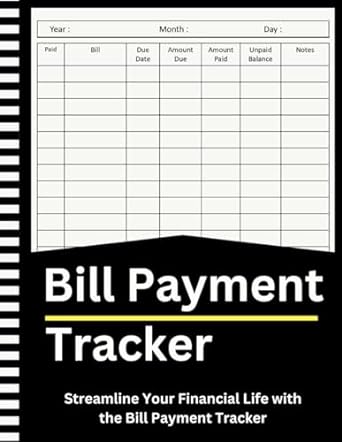Question
Required: 1. Prepare the January 1 journal entry to record the bonds issuance. 2 (a) For each semiannual period, complete the table below to calculate
Required: 1. Prepare the January 1 journal entry to record the bonds issuance. 2(a) For each semiannual period, complete the table below to calculate the cash payment. 2(b) For each semiannual period, complete the table below to calculate the straight-line premium amortization. 2(c) For each semiannual period, complete the table below to calculate the bond interest expense. 3. Complete the below table to calculate the total bond interest expense to be recognized over the bonds' life. 4. Prepare the first two years of a straight-line amortization table. 5. Prepare the journal entries to record the first two interest payments.
Req 1 and Req 5
General Journal:
- Accounts payable
- Accounts receivable
- Accumulated depreciation
- Bond interest expense
- Bond interest payable
- Bonds payable
- Cash
- Common stock
- Contributed capital in excess of par value
- Depreciation expense
- Discount on bonds payable
- Gain on retirement of bonds payable
- Interest payable
- Lease liability
- Leased asset
- Loss on retirement of bonds payable
- Premium on bonds payable
- Rental expense
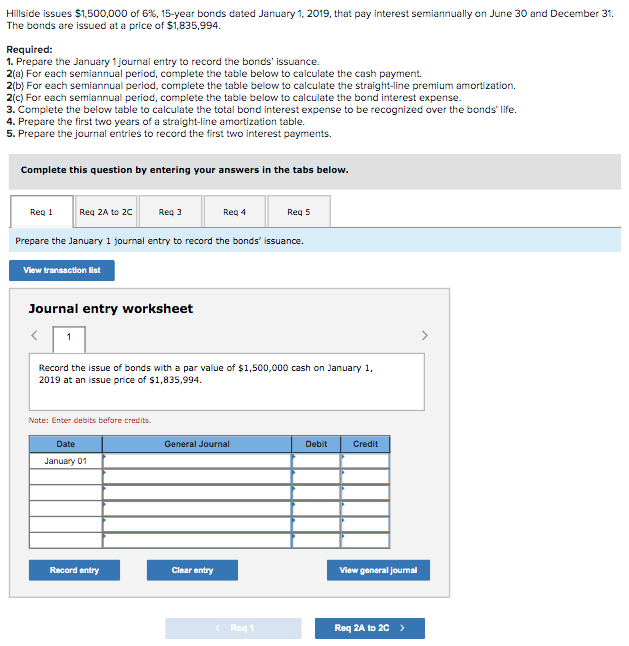
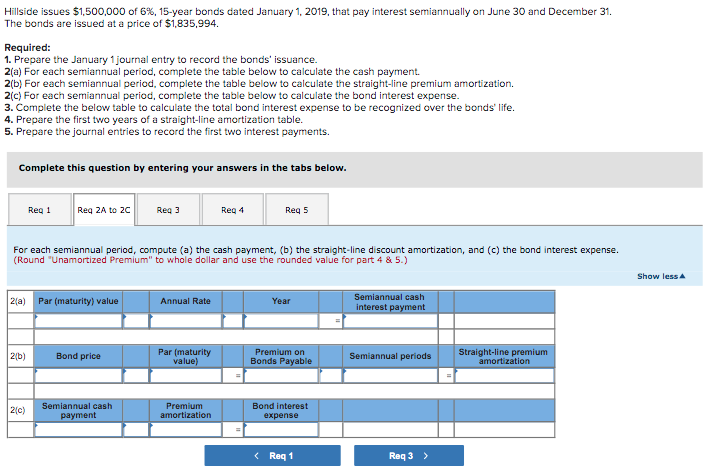
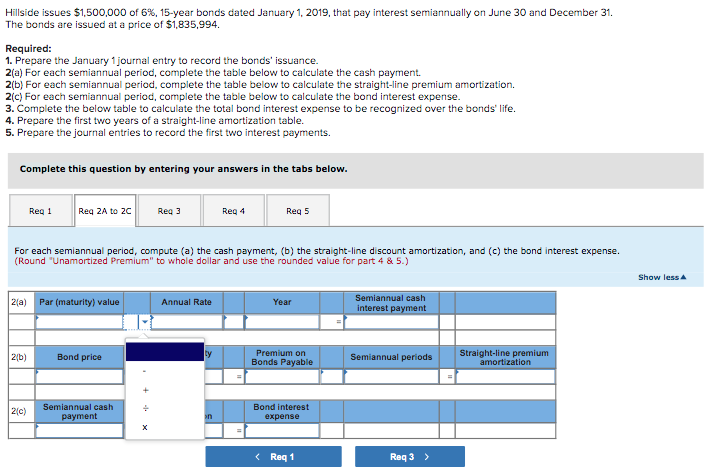

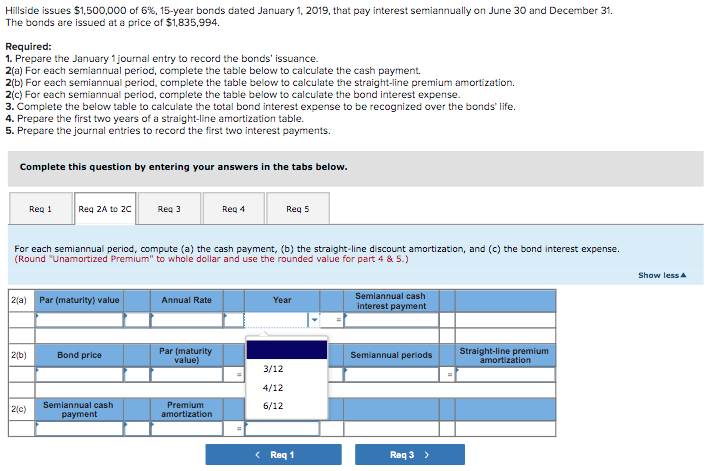
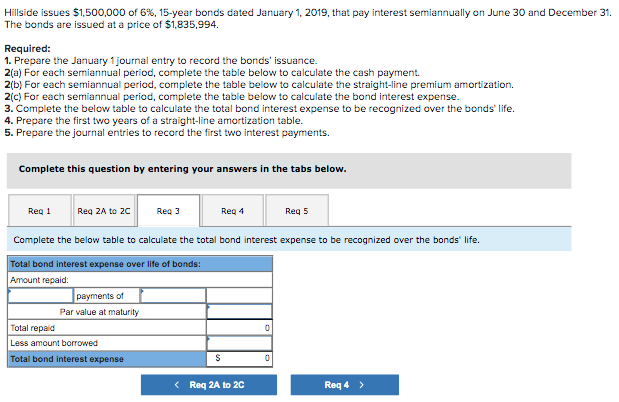
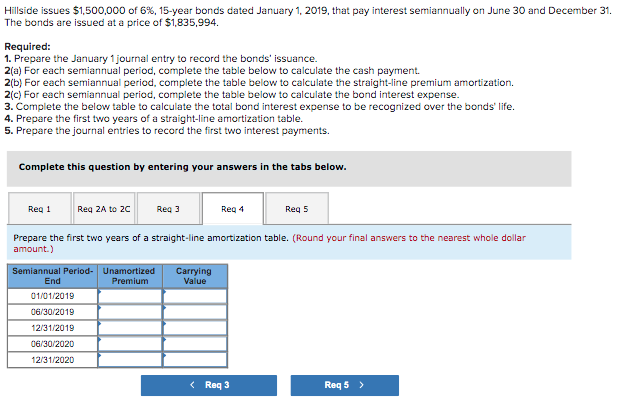
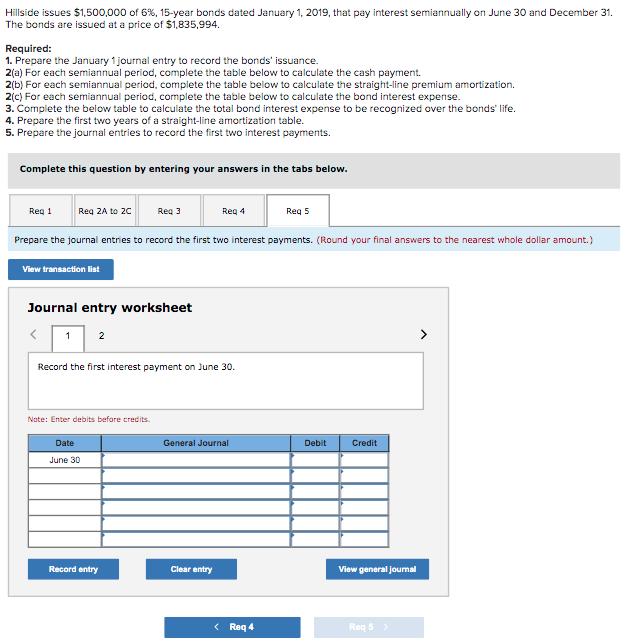
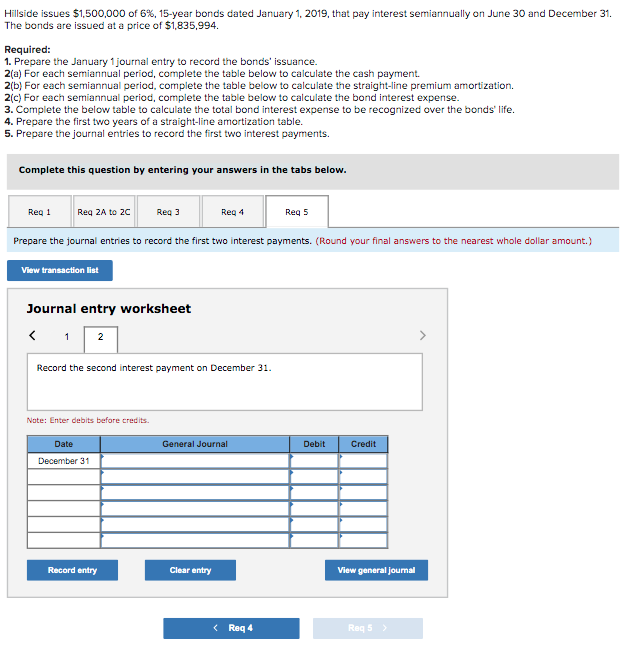
Hillside issues $1,500,000 of 6%, 15-year bonds dated January 1, 2019, that pay interest semiannually on June 30 and December 31. The bonds are issued at a price of $1,835,994. Required: 1. Prepare the January 1 journal entry to record the bonds' issuance. 2(a) For each semiannual period, complete the table below to calculate the cash payment. 2(b) For each semiannual period, complete the table below to calculate the straight-line premium amortization. 2(c) For each semiannual period, complete the table below to calculate the bond interest expense. 3. Complete the below table to calculate the total bond interest expense to be recognized over the bonds' life. 4. Prepare the first two years of a straight-line amortization table. 5. Prepare the journal entries to record the first two interest payments. Complete this question by entering your answers in the tabs below. Reg 1 Reg 2A to ZC Reg 3 Reg 4 Reg 5 Prepare the January 1 journal entry to record the bonds' issuance. View transaction list Journal entry worksheet Hillside issues $1,500,000 of 6%, 15-year bonds dated January 1, 2019, that pay interest semiannually on June 30 and December 31. The bonds are issued at a price of $1,835,994. Required: 1. Prepare the January 1journal entry to record the bonds' issuance. 2(a) For each semiannual period, complete the table below to calculate the cash payment. 2(b) For each semiannual period, complete the table below to calculate the straight-line premium amortization. 2(c) For each semiannual period, complete the table below to calculate the bond interest expense. 3. Complete the below table to calculate the total bond interest expense to be recognized over the bonds' life. 4. Prepare the first two years of a straight-line amortization table. 5. Prepare the journal entries to record the first two interest payments. Complete this question by entering your answers in the tabs below. Reg 1 Reg 2A to 2C Reg 3 Reg 4 Reg 5 For each semiannual period, compute (a) the cash payment, (b) the straight-line discount amortization, and (c) the bond interest expense. (Round "Unamortized Premium" to whole dollar and use the rounded value for part 4 & 5.) Show less 2(a) Par (maturity) value Annual Rate Year Semiannual cash interest payment 2{b) Bond price Par (maturity value) Premium on Bonds Payable Semiannual periods Straight-line premium amortization 21c) Semiannual cash payment Premium amortization Bond interest expense Hillside issues $1,500,000 of 6%, 15-year bonds dated January 1, 2019, that pay interest semiannually on June 30 and December 31. The bonds are issued at a price of $1,835,994. Required: 1. Prepare the January 1journal entry to record the bonds' issuance. 2(a) For each semiannual period, complete the table below to calculate the cash payment. 2(b) For each semiannual period, complete the table below to calculate the straight-line premium amortization. 2(c) For each semiannual period, complete the table below to calculate the bond interest expense. 3. Complete the below table to calculate the total bond interest expense to be recognized over the bonds' life. 4. Prepare the first two years of a straight-line amortization table. 5. Prepare the journal entries to record the first two interest payments. Complete this question by entering your answers in the tabs below. Reg 1 Reg 2A to 20 Reg 3 Reg 4 Reg 5 For each semiannual period, compute (a) the cash payment, (b) the straight line discount amortization, and (c) the bond interest expense. (Round "Unamortized Premium" to whole dollar and use the rounded value for part 4 & 5.) Show less 2(a) Par (maturity) value Annual Rate Year Semiannual cash interest payment 2{b) Bond price Premium on Bonds Payable Semiannual periods Straight-line premium amortization 20) Semiannual cash payment Bond interest expense Hillside issues $1,500,000 of 6%, 15-year bonds dated January 1, 2019, that pay interest semiannually on June 30 and December 31. The bonds are issued at a price of $1,835,994. Required: 1. Prepare the January 1journal entry to record the bonds' issuance. 2(a) For each semiannual period, complete the table below to calculate the cash payment. 2(b) For each semiannual period, complete the table below to calculate the straight-line premium amortization. 2c For each semiannual period, complete the table below to calculate the bond interest expense. 3. Complete the below table to calculate the total bond interest expense to be recognized over the bonds' life. 4. Prepare the first two years of a straight-line amortization table. 5. Prepare the journal entries to record the first two interest payments. Complete this question by entering your answers in the tabs below. Reg 1 Reg 2A to 20 Reg 3 Reg 4 Reg 5 For each semiannual period, compute (a) the cash payment, (b) the straight line discount amortization, and (c) the bond interest expense. (Round "Unamortized Premium" to whole dollar and use the rounded value for part 4 & 5.) Show less 2(a) Par (maturity) value Annual Rate Year Semiannual cash interest payment 2{b) Bond price Premium on Bonds Payable Semiannual periods Straight-line premium amortization 6% 7% 9% 20) Semiannual cash payment Bond interest expense Hillside issues $1,500,000 of 6%, 15-year bonds dated January 1, 2019, that pay interest semiannually on June 30 and December 31. The bonds are issued at a price of $1,835,994. Required: 1. Prepare the January 1 journal entry to record the bonds' issuance. 2(a) For each semiannual period, complete the table below to calculate the cash payment. 2(b) For each semiannual period, complete the table below to calculate the straight-line premium amortization. 2(c) For each semiannual period, complete the table below to calculate the bond interest expense. 3. Complete the below table to calculate the total bond interest expense to be recognized over the bonds' life. 4. Prepare the first two years of a straight-line amortization table. 5. Prepare the journal entries to record the first two interest payments. Complete this question by entering your answers in the tabs below. Reg 1 Red 2A to 20 Reg 3 Reg 4 Reg 5 For each semiannual period, compute (a) the cash payment, (b) the straight-line discount amortization, and (c) the bond interest expense. (Round "Unamortized Premium" to whole dollar and use the rounded value for part 4 & 5.) Show less 2(a Par (maturity) value Annual Rate Year Semiannual cash interest payment 2{b) Bond price Par (maturity value) Semiannual periods Straight-line premium amortization 3/12 4/12 2(c) Semiannual cash payment Premium amortization 6/12 Hillside issues $1,500,000 of 6%, 15-year bonds dated January 1, 2019, that pay interest semiannually on June 30 and December 31. The bonds are issued at a price of $1,835,994. Required: 1. Prepare the January 1journal entry to record the bonds' issuance. 2(a) For each semiannual period, complete the table below to calculate the cash payment. 2(b) For each semiannual period, complete the table below to calculate the straight-line premium amortization. 2c For each semiannual period, complete the table below to calculate the bond interest expense. 3. Complete the below table to calculate the total bond interest expense to be recognized over the bonds' life. 4. Prepare the first two years of a straight-line amortization table. 5. Prepare the journal entries to record the first two interest payments. Complete this question by entering your answers in the tabs below. Reg 1 Reg 2A to 2C Reg 3 Reg 4 Reg 5 Complete the below table to calculate the total bond interest expense to be recognized over the bonds' life. Total bond interest expense over life of bonds: Amount repaid payments of Par value at maturity Total repaid Less amount borrowed Total bond interest expense 0 S 0 Hillside issues $1,500,000 of 6%, 15-year bonds dated January 1, 2019, that pay interest semiannually on June 30 and December 31. The bonds are issued at a price of $1,835,994. Required: 1. Prepare the January 1journal entry to record the bonds' issuance. 2(a) For each semiannual period, complete the table below to calculate the cash payment. 2(b) For each semiannual period, complete the table below to calculate the straight-line premium amortization. 2(c) For each semiannual period, complete the table below to calculate the bond interest expense. 3. Complete the below table to calculate the total bond interest expense to be recognized over the bonds' life. 4. Prepare the first two years of a straight-line amortization table. 5. Prepare the journal entries to record the first two interest payments. Complete this question by entering your answers in the tabs below. Reg 1 Red 2A to 20 Reg 3 Reg 4 Reg 5 Prepare the first two years of a straight-line amortization table. (Round your final answers to the nearest whole dollar amount.) Carrying Value Semiannual Period- Unamortized End Premium 01/01/2019 06/30/2019 12/31/2019 06/30/2020 12/31/2020 Hillside issues $1,500,000 of 6%, 15-year bonds dated January 1, 2019, that pay interest semiannually on June 30 and December 31. The bonds are issued at a price of $1,835,994. Required: 1. Prepare the January 1journal entry to record the bonds' issuance. 2(a) For each semiannual period, complete the table below to calculate the cash payment. 2(b) For each semiannual period, complete the table below to calculate the straight-line premium amortization. 2c For each semiannual period, complete the table below to calculate the bond interest expense. 3. Complete the below table to calculate the total bond interest expense to be recognized over the bonds' life. 4. Prepare the first two years of a straight-line amortization table. 5. Prepare the journal entries to record the first two interest payments. Complete this question by entering your answers in the tabs below. Reg 1 Reg 2A to 2C Reg 3 Reg 4 Reg 5 Prepare the journal entries to record the first two interest payments. (Round your final answers to the nearest whole dollar amount.) View transaction list Journal entry worksheet Record the second interest payment on December 31. Note: Enter debits before credits. Date General Journal Debit Credit December 31 Record entry Clear entry View general journal
Step by Step Solution
There are 3 Steps involved in it
Step: 1

Get Instant Access to Expert-Tailored Solutions
See step-by-step solutions with expert insights and AI powered tools for academic success
Step: 2

Step: 3

Ace Your Homework with AI
Get the answers you need in no time with our AI-driven, step-by-step assistance
Get Started


